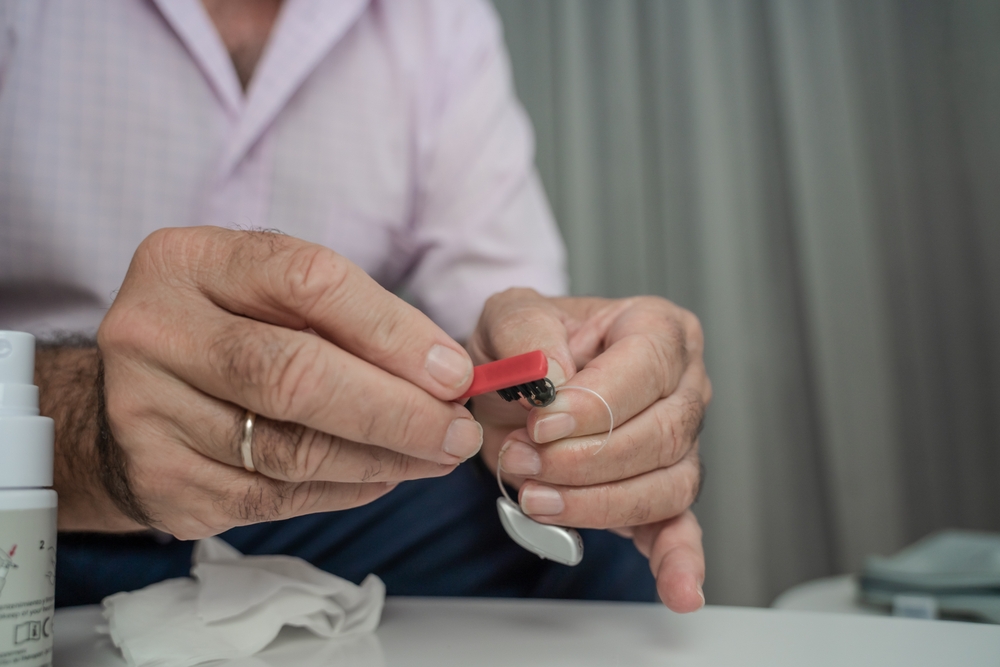
After you have become familiar with wearing your hearing aid, it becomes a vital element of your everyday schedule. The prospect of a malfunction can be distressing, as it presents not only a disruption to everyday life, but also a considerable monetary burden in the form of repair or replacement costs.
Tips for maintaining and optimizing your hearing aid performance
By understanding the prospective hazards that can damage your hearing aid and taking steps to maintain it properly, you can preserve its effectiveness and continue to enjoy the increased quality of life it offers.
Proper battery care
Your hearing aid’s performance is highly dependent on its battery. Thus, it is important to pick the right batteries for your device. Discuss with your audiologist to find out which battery type is most suitable for your specific hearing aid model.
It is just as important to handle the batteries with care. The natural oils, dirt, and moisture on your skin can transfer to the batteries and result in contamination, compromising their performance and potentially leading to damage.
Before switching out the battery, make sure your hands are clean and thoroughly dry to prevent any moisture from getting into the device.
Adhere closely to the manufacturer’s instructions, especially regarding battery upkeep. To prolong the battery life of your hearing aid, make sure to power it down when not using it and keep it stored in a secure, dry location. Knowing the average lifespan of a battery can also be really handy.
Make a note on your calendar every time you replace the battery, so you can estimate when it will need changing again. It’s essential to have a spare battery with you at all times, specifically when you are not at home, in order to avoid being stuck without power all of a sudden.
Prevent moisture damage
As electronic devices, hearing aids are susceptible to moisture. Even slight contact can bring about harm or total failure of the device. Protect your hearing aid’s performance by purchasing a specialized drying device to maintain its functionality by getting rid of moisture. This unit supplies a safe and dry environment for your hearing aid when not in use, safeguarding it from damage caused by excessive moisture.
When engaging in physical activities that cause sweating, you may think about removing your hearing aid to prevent moisture damage. Consult taking off your hearing aid to exercise, particularly outside, with your hearing specialist, as doing so could compromise your safety by decreasing your awareness of important auditory cues, such as traffic noises or warning alarms. If necessary, go with indoor exercise where it’s safer to be without your hearing aid, and always remember to take out your device before showering or swimming.
Furthermore, it is recommended to refrain from using spray deodorants, hairspray, and any other aerosol products when your hearing aid is in your ear. Extended exposure to these products can cause harm to the device, as the moisture and chemicals they contain can accumulate and result in long-term degredation over time. In order to minimize exposure, use these types of products before putting in your hearing aids.
Control earwax buildup
Although earwax serves as a natural shield, protecting your ears from debris, dirt, and small insects, it can also interfere with the effective functioning of your hearing aid. Earwax can build up in the device, causing it to malfunction. For proper maintenance, schedule an appointment with your audiologist or doctor to evaluate the amount of earwax build-up and establish an individualized cleaning plan tailored to your ears and hearing device.
It is necessary to clean your ears carefully and never put anything foreign into your ear canal. Instead of that, let warm water enter your ears while you shower. This can help in losening up and eliminating some of the earwax. It is also suggested to have your ears cleaned routinely by a professional. Though this might be a bit of a hassle, it’s a minor concern in comparison to the frustration and complications that can occur from a hearing aid that’s not functioning effectively due to a buildup of earwax.
To properly clean your hearing aid, carefully adhere to the guidelines provided by the manufacturer.
Different types of hearing aids may require different cleaning techniques, and using the wrong method could cause harm to your device. If you are uncertain about how to clean your hearing aid correctly, it is recommended to seek guidance from your hearing specialist or hearing aid manufacturer.
Basic steps for long-term dependability
Once you get used to using your hearing aids, they become a critical facet of your daily routine, making it difficult to picture life without them. By taking a few simple precautions, you can prevent damage and ensure your hearing aids continue to be reliable for years to come. Prioritize regular upkeep, store them safely, and handle them with care, ensuring you can continue to reap the benefits of enhanced communication and a more fulfilling lifestyle.
If you are having problems with your hearing aid or need to schedule a routine maintenance appointment, please arrange for a visit.
